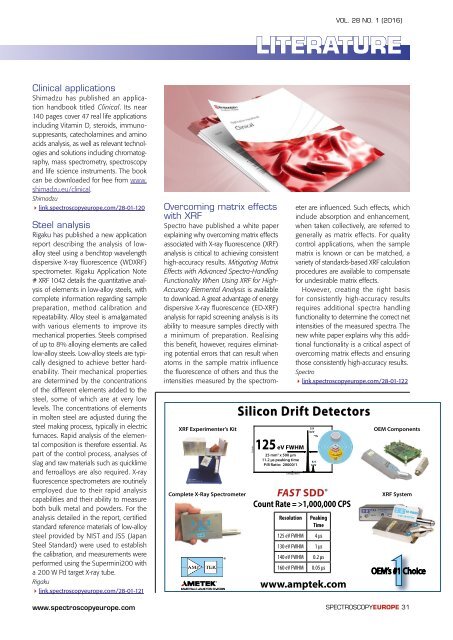Raman spectroscopy of biological pigments Solid mixed matrices in MALDI/TOF-MS
1VpTi1r
1VpTi1r
Create successful ePaper yourself
Turn your PDF publications into a flip-book with our unique Google optimized e-Paper software.
VOL. 28 NO. 1 (2016)<br />
LITERATURE<br />
Cl<strong>in</strong>ical applications<br />
Shimadzu has published an application<br />
handbook titled Cl<strong>in</strong>ical. Its near<br />
140 pages cover 47 real life applications<br />
<strong>in</strong>clud<strong>in</strong>g Vitam<strong>in</strong> D, steroids, immunosuppresants,<br />
catecholam<strong>in</strong>es and am<strong>in</strong>o<br />
acids analysis, as well as relevant technologies<br />
and solutions <strong>in</strong>clud<strong>in</strong>g chromatography,<br />
mass spectrometry, <strong>spectroscopy</strong><br />
and life science <strong>in</strong>struments. The book<br />
can be downloaded for free from www.<br />
shimadzu.eu/cl<strong>in</strong>ical.<br />
Shimadzu<br />
l<strong>in</strong>k.<strong>spectroscopy</strong>europe.com/28-01-120<br />
<br />
Steel analysis<br />
Rigaku has published a new application<br />
report describ<strong>in</strong>g the analysis <strong>of</strong> lowalloy<br />
steel us<strong>in</strong>g a benchtop wavelength<br />
dispersive X-ray fluorescence (WDXRF)<br />
spectrometer. Rigaku Application Note<br />
# XRF 1042 details the quantitative analysis<br />
<strong>of</strong> elements <strong>in</strong> low-alloy steels, with<br />
complete <strong>in</strong>formation regard<strong>in</strong>g sample<br />
preparation, method calibration and<br />
repeatability. Alloy steel is amalgamated<br />
with various elements to improve its<br />
mechanical properties. Steels comprised<br />
<strong>of</strong> up to 8% alloy<strong>in</strong>g elements are called<br />
low-alloy steels. Low-alloy steels are typically<br />
designed to achieve better hardenability.<br />
Their mechanical properties<br />
are determ<strong>in</strong>ed by the concentrations<br />
<strong>of</strong> the different elements added to the<br />
steel, some <strong>of</strong> which are at very low<br />
levels. The concentrations <strong>of</strong> elements<br />
<strong>in</strong> molten steel are adjusted dur<strong>in</strong>g the<br />
steel mak<strong>in</strong>g process, typically <strong>in</strong> electric<br />
furnaces. Rapid analysis <strong>of</strong> the elemental<br />
composition is therefore essential. As<br />
part <strong>of</strong> the control process, analyses <strong>of</strong><br />
slag and raw materials such as quicklime<br />
and ferroalloys are also required. X-ray<br />
fluorescence spectrometers are rout<strong>in</strong>ely<br />
employed due to their rapid analysis<br />
capabilities and their ability to measure<br />
both bulk metal and powders. For the<br />
analysis detailed <strong>in</strong> the report, certified<br />
standard reference materials <strong>of</strong> low-alloy<br />
steel provided by NIST and JSS (Japan<br />
Steel Standard) were used to establish<br />
the calibration, and measurements were<br />
performed us<strong>in</strong>g the Superm<strong>in</strong>i200 with<br />
a 200 W Pd target X-ray tube.<br />
Rigaku<br />
l<strong>in</strong>k.<strong>spectroscopy</strong>europe.com/28-01-121<br />
<br />
www.<strong>spectroscopy</strong>europe.com<br />
XRF Experimenter’s Kit<br />
Complete X-Ray Spectrometer<br />
®<br />
Overcom<strong>in</strong>g matrix effects<br />
with XRF<br />
Spectro have published a white paper<br />
expla<strong>in</strong><strong>in</strong>g why overcom<strong>in</strong>g matrix effects<br />
associated with X-ray fluorescence (XRF)<br />
analysis is critical to achiev<strong>in</strong>g consistent<br />
high-accuracy results. Mitigat<strong>in</strong>g Matrix<br />
Effects with Advanced Spectra-Handl<strong>in</strong>g<br />
Functionality When Us<strong>in</strong>g XRF for High-<br />
Accuracy Elemental Analysis is available<br />
to download. A great advantage <strong>of</strong> energy<br />
dispersive X-ray fluorescence (ED-XRF)<br />
analysis for rapid screen<strong>in</strong>g analysis is its<br />
ability to measure samples directly with<br />
a m<strong>in</strong>imum <strong>of</strong> preparation. Realis<strong>in</strong>g<br />
this benefit, however, requires elim<strong>in</strong>at<strong>in</strong>g<br />
potential errors that can result when<br />
atoms <strong>in</strong> the sample matrix <strong>in</strong>fluence<br />
the fluorescence <strong>of</strong> others and thus the<br />
<strong>in</strong>tensities measured by the spectrometer<br />
are <strong>in</strong>fluenced. Such effects, which<br />
<strong>in</strong>clude absorption and enhancement,<br />
when taken collectively, are referred to<br />
generally as matrix effects. For quality<br />
control applications, when the sample<br />
matrix is known or can be matched, a<br />
variety <strong>of</strong> standards-based XRF calculation<br />
procedures are available to compensate<br />
for undesirable matrix effects.<br />
However, creat<strong>in</strong>g the right basis<br />
for consistently high-accuracy results<br />
requires additional spectra handl<strong>in</strong>g<br />
functionality to determ<strong>in</strong>e the correct net<br />
<strong>in</strong>tensities <strong>of</strong> the measured spectra. The<br />
new white paper expla<strong>in</strong>s why this additional<br />
functionality is a critical aspect <strong>of</strong><br />
overcom<strong>in</strong>g matrix effects and ensur<strong>in</strong>g<br />
those consistently high-accuracy results.<br />
Spectro<br />
l<strong>in</strong>k.<strong>spectroscopy</strong>europe.com/28-01-122<br />
<br />
Silicon Drift Detectors<br />
Counts<br />
125 eV FWHM<br />
25 mm 2 x 500 µm<br />
11.2 µs peak<strong>in</strong>g time<br />
P/B Ratio: 20000/1<br />
Energy (keV)<br />
5.9<br />
keV<br />
6.4<br />
keV<br />
FAST SDD ®<br />
Count Rate = >1,000,000 CPS<br />
Resolution<br />
55 Fe<br />
Peak<strong>in</strong>g<br />
Time<br />
125 eV FWHM 4 µs<br />
130 eV FWHM 1 µs<br />
140 eV FWHM 0.2 µs<br />
160 eV FWHM 0.05 µs<br />
www.amptek.com<br />
OEM Components<br />
XRF System<br />
SPECTROSCOPYEUROPE 31


